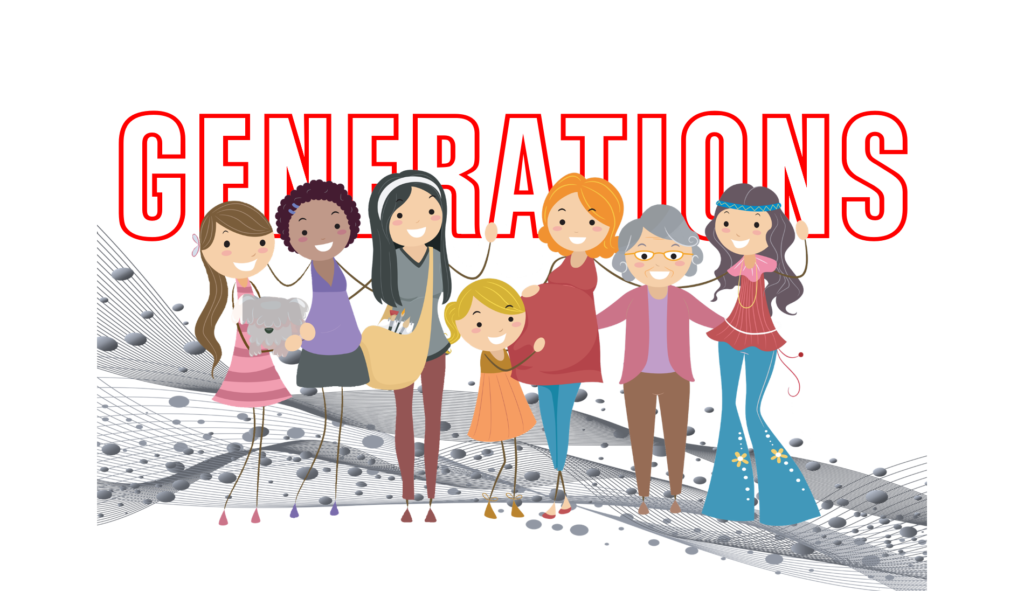Humans love to categorize things. Doing so has enabled us as a species to increase our knowledge and expand our understanding. We have created orders, arrays, frameworks, taxonomies, and groupings. One popular grouping is generations. Compared to most other categorizations, members of “generations” are much more diverse. Often the only thing members of a generation have in common is the historical period in which they were born. Nevertheless, marketers are fond of generational breakdowns. Cara Salpini (@CaraSalpini) observes, “Marketing by generation has been a go-to technique for retailers for what feels like forever — and it does have its uses.”[1] Despite the diversity found within generations, people of a certain age do have requirements for products not needed by older or younger individuals (e.g., baby bottles for newborns and walkers for older people). Those product commonalities are for what marketers are searching. As Salpini explains, “The technique can be helpful for those looking to identify trends in a certain age group or to help better target the right products to the right customers.”
What Generations are Currently in Play?
You might be wondering: What constitutes a generation? Who defines what time period makes up a generation? The fact of the matter is the media is primarily responsible for drawing generational boundaries. Journalist Philip Bump (@pbump) noticed different publications defined generational time periods differently so he took on the challenge of providing a definitive answer for what constitutes members of various generations.[2] Below are his breakdowns.
Greatest Generation (1930ish to 1946). Bump writes, “These are the people [who] fought and died in World War II for our freedom, which we appreciate. But it’s a little over-the-top as far as names go, isn’t it? Tom Brokaw made the name up and of course everyone loved it. What, you’re going to argue with your grandfather that he isn’t in the greatest generation? The generation ended when the war ended.”
Baby Boomers (1946 to 1964). Bump reports Baby Boomers are the only generation officially recognized by the Census Bureau. “It began when the Greatest Generation got home and started having sex with everyone; it ended when having sex with everyone was made easier with The Pill.”
Generation X (1965 to 1984). According to Bump, “George Masnick, of the Harvard Joint Center for Housing Studies puts this generation in the timeframe of 1965 to 1984, in part because it’s a neat 20-year period. He also calls it the ‘baby bust,’ mocking ‘pundits on Madison Avenue and in the media’ [who] call it Generation X.” Some marketers have also referred to Generation X as the lost generation because marketers often overlooked it as they concentrated on Baby Boomers and Generation Y.
Generation Y or Millennials (mid-1970ish to 2004). Here’s where things get messy. Bump reports, “Masnick addresses this group, too, putting it ‘anywhere from the mid-1970s when the oldest were born to the mid-2000s when the youngest were.’ But mostly Generation Y is a made-up generation when it became obvious that young kids didn’t really fit with the cool Generation X aesthetic but not enough of them had been born to make a new generation designation.” Bump adds the following note: “Generation Y is a fake, made-up thing. Do not worry about it.” Generation Y is often referred as the Millennial Generation (or simply Millennials) Bump writes, “In October 2004, researchers Neil Howe and William Strauss called Millennials ‘the next great generation,’ which is funny. They define the group as ‘as those born in 1982 and approximately the 20 years thereafter.’ In 2012, they affixed the end point as 2004.”
Generation Z (2004 to the present). When Bump wrote his article back in 2014, the next generation had yet to be named. He referred to it as the TBD generation. He wrote, “Kids born in the last 10 years lack a designation.” Since then, the media has taken the easy road and continued with the alphabet designation calling the latest grouping Generation Z. Members of Generation Z have also been called Centennials.
For marketers, all of those generations, with the possible exception of the Greatest Generation, are still in play. In another article, Salpini writes, “A good marketer can kick it old school with the boomers and float the perfect hashtag to Gen Z.”[3]
Marketing to Different Generations
Keeping in mind generations are “fake,” Salpini notes, “Retailers are often blind to the limitations of generational marketing and, to some extent, they use the technique as a crutch to hold up lackluster marketing efforts.” Salpini doesn’t dismiss generational targeting altogether; rather, she believes it should be the starting point not the end point of marketing strategies. She explains, “There’s a lot to be said for generational marketing, but retailers should really focus on using it to identify generational channels or trends, rather than as the linchpin of their marketing strategy, according to Lauren Bitar, director of retail consulting at RetailNext. ‘There’s generally some truth behind stereotypes,’ Bitar said. ‘It’s a good starting point to think about [but] that doesn’t mean you don’t want to dive deeper.’ And finding the right channel to market on is a great example.”
In previous eras of mass marketing, the channels of choice were print media then radio then television. Segmentation was often done by gender rather than age. Men’s products were advertised in sports sections, men’s magazines, and during sporting events. Women’s products were advertised in society sections, women’s magazines, and on daytime television. Today, there are many more channels available and much better techniques to target consumers. Salpini explains, “Retailers who have a very youth-centered product will probably want to focus on mobile and social media. Gen Z, for example, converts twice as much on mobile as any other generation and are also twice as influenced by social media platforms as they are by deals. That’s not to mention certain social platforms that are growing in significance, like Snapchat, which influences 21% of Gen Z (already twice the number of millennials).” Cognitive technologies can help marketers find the right channel, the latest trends, the best message, and the right product to reach consumers. For example, the Enterra Shopper Marketing and Consumer Insights Intelligence System™ can leverage all types of consumer data to provide high-dimensional consumer, retailer and marketing insights.
Summary
Vignesh Clingam, managing partner and Senior Vice President of experience analytics at RAPP, notes, “Predicting consumer habits solely by focusing on identifiers such as demographics is misguided. Even formerly successful marketing campaigns based on these techniques are now struggling.”[4] Salpini adds, “A retailer who’s just beginning might want to test out more general marketing tactics, but the goal should always be to learn more about the customer and move beyond the type of square-one targeting generational marketing can provide.” Clingam agrees. He explains, “As multicultural, multigenerational family structures continue to increase and diversify, it will be even more difficult to fit consumers into a single demographic bucket. Thus, digital behaviors, technology adoption, political affiliation, and social causes are consistently stronger predictors of buying habits than more traditional segments. Shifting marketing efforts to this needs-based segmentation approach therefore provides several advantages.” Trying to market to generations doesn’t achieve superior results because members of these generations are too diverse to stereotype effectively. Cognitive technologies can be leveraged to better target consumers regardless of the generation to which they belong.
Footnotes
[1] Cara Salpini, “Why generational marketing could send retailers back to the drawing board,” Retail Dive, 14 February 2018.
[2] Philip Bump, “Here Is When Each Generation Begins and Ends, According to Facts,” The Atlantic, 25 March 2014.
[3] Cara Salpini, “The definitive guide to generational marketing,” Retail Dive, 20 October 2017.
[4] Vignesh Clingam, “Segmentation Models Are Outdated: How to Update Your Marketing Segmentation Practices,” MarketingProfs, 10 January 2018.




